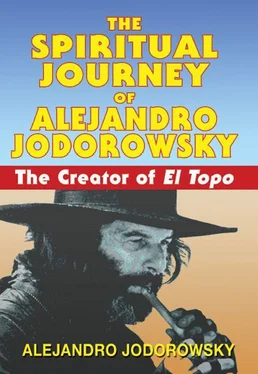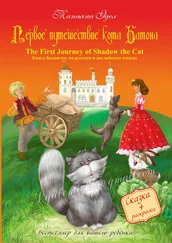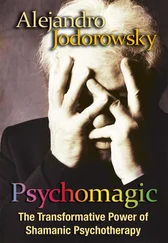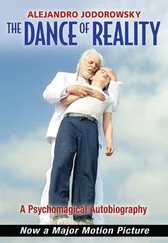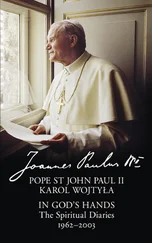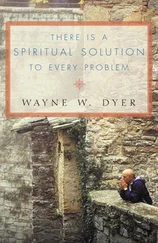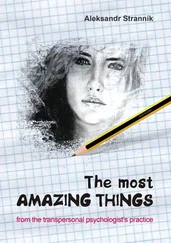Some time previously, Maria Sabina had apparently initiated contact with me through the intermediary of a painter friend, Francisco Fierro. Returning from Huautla, where he went to eat mushrooms with the curandera, Francisco had brought me a jar of honey in which were embedded six pairs of the niñitos santos , or the “sacred little children.”
“These are a gift to you from Maria Sabina. She saw you in a dream. It seems you are going to accomplish a work that will help the world realize the true values of our culture. Nowadays, the hippies are destroying the ancient traditions. Huautla is overrun by tourists, drug dealers, journalists, doctors, soldiers, and police agents. The niñitos santos have lost their purity. But these twelve apostles are special, because they have been blessed by abuelita. Eat all of them.”
I have already recounted my experience with these magic mushrooms in La Danse de la Réalité , but I must confess that at first I had doubts about my painter friend. Perhaps the old woman had not really dreamed of me; perhaps, with all the best intentions, Francisco had concocted the story himself. I found it difficult to believe that someone could influence reality through dreams, yet Francisco insisted that these mushrooms contained all the wisdom of ancient Mexico. He ate them often, and he did not hesitate to feed them to his young daughters — two strange creatures who were five and six years old, with large, adult eyes.
Hence my utter astonishment when, on the same morning that I woke up with my ankles healed, I received a phone call from Francisco Fierro: “Tonight, abuelita visited me in my sleep and told me that she was going to heal you. How were you feeling when you woke up this morning?”
Coincidence? Telepathy? Could Maria Sabina really enter into my dreams and heal my body in that dimension? My intuition said yes, my reason said no. This is why I have not included Maria Sabina as one of the characters in this book: I cannot exclude the possibility that she is a sort of illusion personal to me. In any case, whether illusion or reality, Maria Sabina continued to appear in my dreams until the time of her death — always in difficult moments, and always in a way that was very helpful to me.
The third person absent in this account is the Chilean singer Violeta Parra. Her fame is so great — she is praised by poets such as Pablo Neruda (“a saint of the finest clay”), Nicanor Parra (“a bird of earthly paradise”), Pablo de Rokha (“subterranean simplicity”), and so many others — that what I could add would be superfluous. I met her in Paris, where she resided during two periods: first in 1954 for two years, then in 1961 for three years. During the first period she was not yet famous, and she earned her living singing in a small cabaret in the Latin Quarter called L’Escale . Her miserable wages were just enough to pay for a room in a one-star hotel. There, she often cooked a simple Chilean meal of char-grilled meat, cornbread, and tomato and onion salad, which she would share with her six main friends, of whom I was one. She refers to this in her autobiography, written in verse:
As the law commands,
justice must be rendered in all things;
obeying this with delight,
I hereby name six
archangels, who, you see,
protect me with their friendship,
offering me affinity in this distant world;
and when their hands reach out to me,
my darkness lights up.
I say it and repeat it:
a little heart of coriander
for my friend Alejandro,
who comforted me in Paris
with a clove-scented flower
and a friendly smile.
His hand was a delight
down there in that absent life;
yesterday, you planted some seeds;
today, they flower and bear fruit.
She says that I comforted her in Paris, but it was she who helped me, inspiring me with her tenacity and energy. Violeta would sing from ten o’clock at night until four in the morning, then get up at eight o’clock and rush off to record Chilean folk songs (“to the human and to the divine”), which she had collected and learned directly from the lips of old peasants. She recorded these for the Chant du Monde ethnomusicology library, and for the Phonothèque Nationale at the Musée de l’Homme. *1
I was indignant: “But Violeta, they are not paying you a centime for this! You must see that they are exploiting you in the name of culture!”
“I’m not stupid. I know they’re exploiting me, but I do it with pleasure. France has one of the greatest museum cultures, and I know they will always conserve these songs. I’m saving an important part of Chilean folklore. For the good of my country’s music, it doesn’t matter if I work for free. In fact, I’m even proud not to be paid for it! Sacred things should be protected from the power of money.”
Thus Violeta taught me a lesson I never forgot. It was her example that inspired me always to offer tarot readings and psychomagic counseling free of charge.
When she returned to Paris seven years later, it was as a singer who was famous and respected in Chile not only for her art but also for her precious research in forgotten folklore. Now she recorded her own songs on the famous Barclay label (including the celebrated Gracias a la Vida ). She also sang at the huge annual festival of popular music organized by l’Humanité , the French communist daily newspaper. In spite of this success, she remained a simple woman, resembling a humble peasant. Yet her delicate frame was inhabited by a soul of superhuman strength.
One day, she and I walked together along the banks of the Seine and arrived at the Louvre.
“What an incredible museum!” I exclaimed. “The weight of so many great works of art, so many great civilizations. . we poor Chileans are crushed by it. Our traditions are mere straw huts compared to pyramids, mere clay pots compared to the Sphinx. .”
“Be quiet!” she commanded me with an imperious tone. “The Louvre is a cemetery. But we — we are alive! Life is more powerful than death. I’m just a tiny woman, but this huge edifice doesn’t impress me. Mark my words: Before long, you’ll see my works exhibited here.”
I didn’t know whether to consider her crazy or just the victim of an extremely naive vanity. Besides, she was a singer, not a painter or sculptor!
Violeta had very little money. She bought some iron wire, some cheap rag cloth, some wool of different colors, some clay, and some tubes of oil paint. With these modest materials, she began to fashion tapestries, jugs, little sculptures, and oil paintings. They were her own works, yet they also were an expression of a Chilean folklore that had disappeared from history but was still alive in my friend’s unconscious. In April 1964, Violeta Parra inaugurated her great exhibition at the Musée des Arts Décoratifs at the Marsan Pavillion attached to the Palace of the Louvre!
This incredible woman taught me that if we desire something with the totality of our being, we will finally achieve it — perhaps not always as rapidly as in this instance, yet Violeta showed me that the impossible becomes possible through patience and commitment.
I saw another example of this immense patience and perseverance in the Spanish writer Francisco Gonzalez Ledesma, who, under the pseudonym Silver Kane, wrote more than a thousand cowboy novelettes for the popular market. He began producing them in 1951, when he was twenty years old, in order to earn his living. He continued until 1975, at the rate of one book a week. After that and continuing to the present, he began to write under his real name. These were the books he really wanted to write: a type of detective novel written in high literary style. These works earned him the Planète Prize in 1984 and also the French Mystère Prize for the best foreign novel.
Читать дальше
